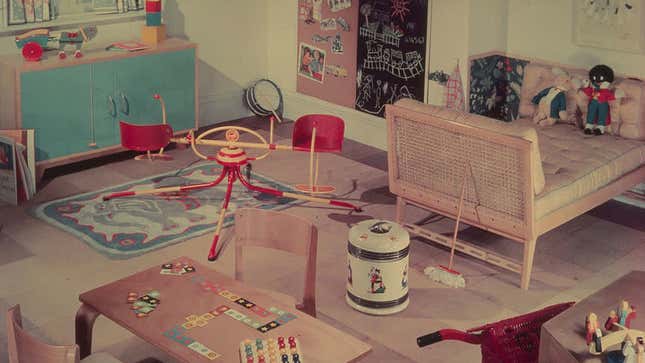The Aspirational Fantasy of the Perfect Playroom
In Depth

A handful of life-size miniature horse toys to ride. A sleek, tiny ball-pit and accompanying slide. A stage with karaoke microphones and enough instruments to support a professional band. These are just some of the toys in the white-walled Kardashian-West playroom, which Kim Kardashian recently posted on Instagram.
“Just because you guys always say my house is so, like, minimal… well, you guys haven’t seen my playroom,” she says as her phone scans neatly organized baby carriages, dollhouses, and hidden drawers filled with color-coordinated Legos and cars.
What might be a messy, innocuous space for many parents is, for Kardashian, a signifier of her thoughtful parenting. It didn’t just say, “Look at all of the toys we have,” but also, “Look at all of the right toys.” And “look how neatly they’ve all been put away!” But Kardashian is hardly alone. Hundreds of parents share images of their playrooms on social media each day, showing off their uniquely curated rooms built just for children that look frozen in a state of calm.
Perfect playrooms—clean, highly organized, expertly designed like any other adult room in the house—proliferate on Instagram and Pinterest. Parents with accounts with tens of thousands of followers document the pretty, quiet moments of their playrooms, from intimate moments of playtime to how toys get tucked away and cataloged on shelves, and rarely do the most popular look like a simple, carpeted den with a few buckets of toys in the corner. Families can hire interior designers who specialize in playroom design, who install rock-climbing walls or makeover refurbished basements into mini classrooms.
And it’s not just how the playrooms look, but how kids play specifically, that’s photographed. Popular accounts like @inspiremyplay and @littleplayideas document all sorts of brain-building exercises for children that go beyond toys purchased on Amazon. Montessori, Reggio, and Waldorf-inspired accounts are abundant. The playroom—an upper to middle-class largely suburban luxury given that its existence requires extra space—persists as an aspiration in the 21st century: the dream of a beautiful, carefully thought-out space for one’s child.
-

-

-

-

-

-

-

-

-

-

-

-

-

-

-

-

-

-

-

-

-

-

-

-

-

-

-

-

-

-

-

-

-

-

-

-

-

-

-

-








































